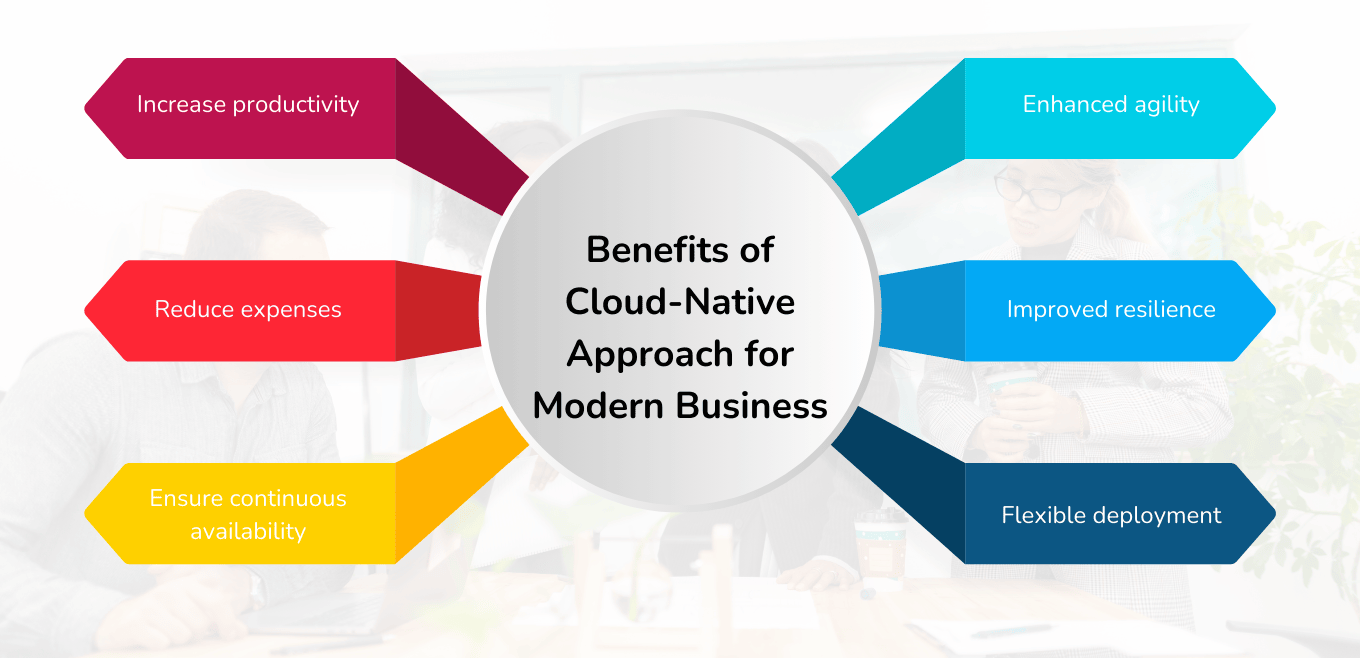The demand for cloud-native apps is skyrocketing due to their multiple benefits. As per research by McKinsey, Experts estimate the cloud-native application market will reach $5.9 billion in 2023 and $17 billion by 2028.
Businesses meet today’s demands using cloud-native applications that follow modern development principles and standards. Businesses are fundamentally shifting how they construct and deploy applications. At its core, being cloud-native represents an approach where applications are intentionally designed to utilize cloud infrastructure, rather than a traditional development that capitalizes on scalability, adaptability, and efficiency.
In this blog, we explore the world of cloud-native development strategies. We will explain the fundamental principles and practices that empower organizations to make the most of cloud computing’s potential in crafting resilient, highly available, and easily maintainable software solutions.
Key Characteristics of the Cloud-Native Approach
A specialized approach for creating and managing apps made especially for cloud settings is called cloud-native application development. To effectively profit from cloud computing, it entails developing software from the ground up rather than just migrating pre-existing apps to the cloud.
Cloud teams collaborate to achieve remarkable platform scalability and flexibility in native cloud development. Cloud teams use cutting-edge software technologies that fully automate the development, software testing, and deployment of cloud applications. These technologies enable teams to quickly set up and replicate microservices, unlike conventional enterprise software development.
Businesses now develop cloud-native apps for hybrid or private clouds, not just public clouds. Additionally, they can be created for hybrid or private clouds. This approach modernizes the cloud, improves application performance, and optimizes cloud usage.
Benefits of Cloud-Native Approach for Modern Business

The cloud-native strategy is revolutionary in today’s digital environment since it provides businesses with several benefits. Businesses can increase productivity, save expenses, and guarantee the continuous availability of their apps by implementing a cloud-native strategy.
Increase productivity
By implementing agile techniques like DevOps and continuous delivery (CD), cloud-native development transforms the effectiveness of application development. Developers can use cloud services, automated technologies, and a contemporary design ethic to quickly create scalable applications.
Reduce expenses
By adopting a cloud-native strategy, businesses can avoid spending money on the acquisition and upkeep of costly physical infrastructure. Long-term operational expenditure savings are substantial as a result. Additionally, clients may benefit from the cost savings associated with developing cloud-native solutions.
Ensure continuous availability
Cloud-native technology enables businesses to develop highly accessible and robust applications. Companies can easily scale app resources during peak seasons and feature upgrades no longer result in downtime, guaranteeing a smooth and satisfying user experience.
Enhanced agility
Cloud-native technologies allow for quicker software development and delivery of applications. Building apps with loosely coupled but readily testable and deployable components is made easier by utilizing container technology in conjunction with a microservices approach.
Improved resilience
Because cloud-native apps are naturally resilient and fault-tolerant, you can use container orchestration platforms like Kubernetes to make it possible for apps to autonomously recover from failures without human assistance.
Flexible deployment
Automation is supported by a cloud-native approach to application deployment and administration. CI/CD pipelines with infrastructure as code (IaC) simplify and streamline the deployment process. Developers can work together efficiently by using an IaC strategy to share deployment operations.
Build Resilient and Highly Available Applications with Cloud Native
How to Modernize Your Application with Cloud-Native Architecture?
Refactoring entails changing an application’s fundamental code to make it cloud-native, whereas re-platforming and repackaging already-existing apps will enable them to run on the cloud.
The following three general steps will walk you through the process of developing cloud-native software if you’re prepared to go right into digital transformation.
Containerize legacy applications
The proper tools, specifically orchestration and containerization technologies, are the first step in a successful containerization project.
Containerization tools allow software developers to efficiently package applications with their associated dependencies. Whereas orchestration technologies are what enable those programs to collaborate across a cloud environment. Developers widely use Amazon Elastic Kubernetes Services (EKS) and Docker for orchestration and containerization.
Together, they assist businesses in managing their containerization initiatives. Whether your cloud journey is supported by server-based, cloud-based, or hybrid infrastructure, application orchestration solutions enhance coordination and provide better performance.
Break down monoliths into microservices
Refactoring is the process of disassembling monolithic architecture into adaptable, completely contained microservices because monolithic architecture is inflexible and stiff. A typical monolithic architecture connects the frontend user interface with backend business logic and data layers. When a monolith is divided into microservices, the resulting application is:
- Flexible and scalable
- Constructed to resist failure
- Able to precisely and uniquely meet particular company needs
- Extremely trustworthy, to ensure an exceptional client experience
Each containerized component is linked to a particular feature or function, has its data to pull from, and has its business logic instead of sharing a data center. Teams must consider potential difficulties when implementing new cloud-native technology. Throughout your project, make sure you collaborate with skilled developers to mitigate risks such as data loss, security breaches, and outages.
Implement API-first strategies
Careful road mapping and strategic planning are necessary when developing products using an API-first methodology. A seamless transition to a native-app environment can be ensured by working inside the appropriate framework.
The following guidelines must be followed while implementing an API-first strategy.
- Strategic planning: Before writing a single line of code, give careful thought to documentation and design. This enables you to create APIs that work flawlessly with other software systems in your ecosystem and are consumable. Additionally, it facilitates the construction of modular applications and parallel development.
- Evaluating the complexity of the system: An API’s complexity can be affected by several things, such as the protocol your business chooses to use (SOAP vs. REST) and how you approach solving particular issues.
- Ensuring compatibility: Establishing compatibility and communication between two systems is the main goal of an API. Instead of relying on other developers to create compatible systems after the fact, an API-first strategy guarantees compatibility as a built-in feature of an application.
- Minimizing user disruption: Any transformation, including the usage of API-first solutions, must minimize disturbances. Strict adherence to version-control best practices, thorough documentation, and a cloud migration that minimizes breakage are all necessary for this.
Using approaches like Agile and DevOps, which enable a deliberate approach with transparent communication at every level, is beneficial for implementing cloud-native software since it necessitates a clear roadmap.
Choosing the Right Cloud Services
A lot of things should be taken into account when selecting a cloud service provider, with particular attention paid to what would best serve your company’s needs. When selecting a provider, take into account the following:
- Expenses and your financial capacity
- Adaptability and personalization
- Usability and the learning curve for novice users
- Sturdiness and power
- Dependability and performance history
- Innovation and distinctive elements, such as data collection tools and AI integrations
Future Trends in Cloud-Native Development


The cloud-native environment is changing quickly. The way apps are created and implemented is changing as a result of the new developments.
AI/ML Integration: AI and ML are becoming essential components. More individualized user experiences, predictive analytics, and intelligent automation are made possible by these technologies. Cloud-native apps that use AI/ML enable significant innovation at scale, real-time data processing, and decision-making.
Edge Computing: As low-latency applications become more and more necessary, edge computing is becoming a crucial part of cloud-native development. It is perfect for IoT and real-time applications because it lowers latency and bandwidth consumption by processing data closer to the source. Cloud-native architectures combined with edge computing provide more dispersed, robust, and efficient systems.
Serverless Evolution: With developments in Function-as-a-Service (FaaS) and Backend-as-a-Service (BaaS), serverless computing is still developing. These technologies are lowering application operational overhead and streamlining the software development process.
These trends will converge to shape the future of cloud-native development, enabling companies to create more inventive, scalable, and agile apps that can change with the market.
Conclusion
Cloud-native development is an essential strategy for modern businesses aiming to stay competitive with resilient & scalable applications. Businesses unleash the potential of cloud-native apps by adopting serverless computing, CI/CD pipelines, microservices, and containerization.
We’ve witnessed every stage in the rise of cloud-based computing, and we’ve been active participants in enterprise app modernization. As a result, we have created, tested, and implemented innumerable cloud-native applications for our clients.
If you’re looking to dive headfirst into your digital transformation strategy with cutting-edge, cloud-native apps designed to thrive on a modern infrastructure, you’ll want to explore your options with one of our specialists.
Take the Leap into Cloud-Native Excellence with People10
Author
Kamal Chauhan excels in DevOps and automation, focusing on infrastructure and application deployment solutions. He designs and implements automated deployment pipelines for diverse applications and sectors.




